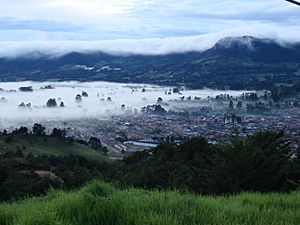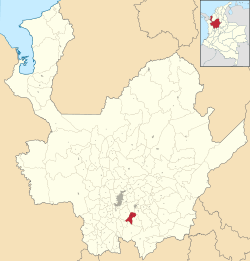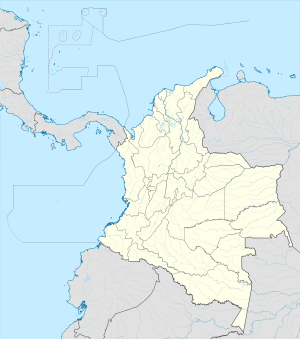La Ceja, Antioquia facts for kids
Quick facts for kids
La Ceja
|
||
|---|---|---|
|
Municipality and town
|
||
 |
||
|
||

Location of the municipality and town of La Ceja in the Antioquia Department of Colombia
|
||
| Country | ||
| Department | ||
| Subregion | Eastern | |
| Founded | 1789 | |
| Area | ||
| • Municipality and town | 131 km2 (51 sq mi) | |
| • Urban | 4.03 km2 (1.56 sq mi) | |
| Elevation | 2,200 m (7,200 ft) | |
| Population
(2018 census)
|
||
| • Municipality and town | 64,889 | |
| • Density | 495.3/km2 (1,283/sq mi) | |
| • Urban | 54,820 | |
| • Urban density | 13,603/km2 (35,230/sq mi) | |
| Demonym(s) | Cejeños | |
| Time zone | UTC-5 (Colombia Standard Time) | |
| Area code(s) | 57 + 4 | |
La Ceja, also known as La Ceja del Tambo, is a town and municipality in the Antioquia Department of Colombia. It is part of the Eastern Antioquia region. La Ceja shares borders with towns like Rionegro, Carmen de Viboral, La Unión, Montebello, and Retiro. It is about 41 kilometers (25 miles) from Medellín, the capital city of Antioquia.
The town has good roads connecting it to other places in Antioquia. These include major highways like the Medellin-Bogota road. There are also other important routes such as the Las Palmas roads.
Father Germán Montoya wrote the town's special song, called the "Hymn of La Ceja del Tambo". Donato Duque Patiño designed its flag.
Contents
History of La Ceja
Early Inhabitants and Spanish Arrival
Long ago, the land where La Ceja now stands was home to the Tahamíes people. They were an indigenous group who focused on farming, especially growing maize (corn). In 1541, Spanish explorers arrived in this area. They were led by Álvaro de Mendoza, who worked for Marshal Jorge Robledo.
When Mendoza reached this region, he found a huge, fertile valley. It was full of green fields and had lots of clean water. He named it the "Valley of Santamaría." Today, we know it as the "Valley of La Ceja del Tambo."
Growth and Settlement
Starting in the early 1600s, many people from Antioquia began moving to this area. They came from cities like Medellín and Santa Fe de Antioquia. They were attracted by the beautiful nature and the rich land. This land was perfect for farming and raising livestock (farm animals).
In 1683, a new path was made between San Nicolás de Rionegro and Santiago de Arma. This path also led to Popayán. Along this route, local people built a shelter, or "tambo," for travelers. This shelter is why the town later got the name "La Ceja del Tambo."
Founding and Municipality Status
The town was officially founded as "La Ceja" on December 7, 1789. It was founded by María Josefa Marulanda Londoño and Father José Pablo de Villa.
By 1824, the town had 2,012 people living there. La Ceja became an official municipality in 1855. In 1905, plans were made to install a water system. The first water and sewer systems started working in 1927.
Population of La Ceja
How Many People Live Here?
In 2018, a census counted the population of La Ceja. It found that 64,889 people lived in the town.
In 2009, the total population was 48,879 people. Most of these people, about 41,587, lived in the urban (city) areas. The remaining 7,292 people lived in the rural (countryside) areas.
Who Lives in La Ceja?
According to a 2005 census, the people living in La Ceja are mostly of two main groups:
- White and Mestizo (people of mixed European and indigenous heritage): 92.1%
- Afro-Colombian (people of African heritage): 7.9%
Economy of La Ceja
Farming and Animals
Unlike some other towns in eastern Antioquia that focus on mining, La Ceja has always been known for its agriculture and raising livestock.
The main crops grown in the municipality are tamarillo (a fruit), bananas, blackberries, and coffee. Farmers also grow many other fruits and vegetables.
Raising dairy cows has been a very important part of the economy for a long time. Today, the region produces about 70,000 liters of milk every single day!
Flower Production
To the north of the town, there are many farms that grow cut flowers. These farms export (send) their flowers to other countries, mainly the United States. Growing flowers provides the most jobs for people living in La Ceja. The main types of flowers grown here are chrysanthemums, hydrangeas, gerberas, and asters.
Places to Visit in La Ceja
La Ceja has more than a thousand different businesses. You can find restaurants, cafes, shops, hotels, and health centers. There are also schools, entertainment spots, and travel agencies.
The main town square has two churches. One is the Chapel of Our Lady of Chiquinquirá. The other is the Minor Basilica of Our Lady of Carmen. The Chapel of Our Lady of Chiquinquirá is also like a museum of religious art. It has beautiful artworks by famous artists such as Gregorio Vasquez de Arce y Ceballos.
Other interesting places to see include:
- Buey river waterfall
- Pantanillo river
- Juan de Dios Aranzazu Theater
- Gregorio Gutiérrez González House of Culture
Besides all the typical foods of the Paisa region, La Ceja is famous for its delicious sweets. These include custards, jams, jellies, arequipes (a type of caramel), chocolate treats, and panelitas (small sweet candies).
Images for kids
See also
 In Spanish: La Ceja para niños
In Spanish: La Ceja para niños









